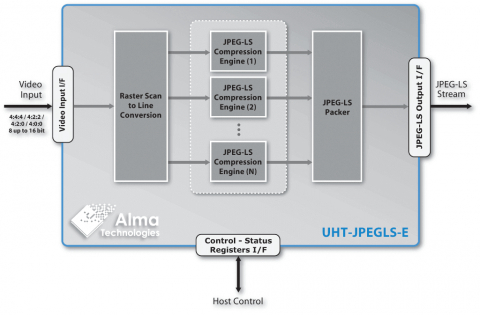Scalable Ultra-High Throughput JPEG-LS Encoder
JPEG-LS is based on the LOCO-I (Low Complexity-Lossless Compression for Images) image compression algorithm, which uses a non-linear predictive scheme with rudimentary edge detecting capability, based on the four nearest –causal- neighbours (left, upper left, upper and upper right) and an entropy encoder using adaptively selective Golomb-type codes. The low complexity scheme of JPEG-LS is based on the assumption that prediction residuals follow a two-sided geometric distribution and the fact that Golomb-codes are optimal for geometric distributions, thus the modeling and coding units are matching.
UHT-JPEGLS-E is very easy to use and integrate in a system. It requires minimal host intervention as it only needs to be programmed once per video sequence. Once programmed, it can encode an arbitrary number of video frames without the need of any further intervention or assistance by the host system CPU.
UHT-JPEGLS-E accepts the uncompressed raw video data in interleaved scan format. It outputs standalone, standard compliant, JPEG-LS byte stream format. No post processing on the output stream, other than (as examples) saving, muxing, or transmitting, is required by the host. The output JPEG-LS byte stream can be decoded, as is, by any corresponding ISO/IEC IS 14495-1 | ITU-T Recommendation T.87 compliant decoder.
View Scalable Ultra-High Throughput JPEG-LS Encoder full description to...
- see the entire Scalable Ultra-High Throughput JPEG-LS Encoder datasheet
- get in contact with Scalable Ultra-High Throughput JPEG-LS Encoder Supplier
Block Diagram of the Scalable Ultra-High Throughput JPEG-LS Encoder IP Core









